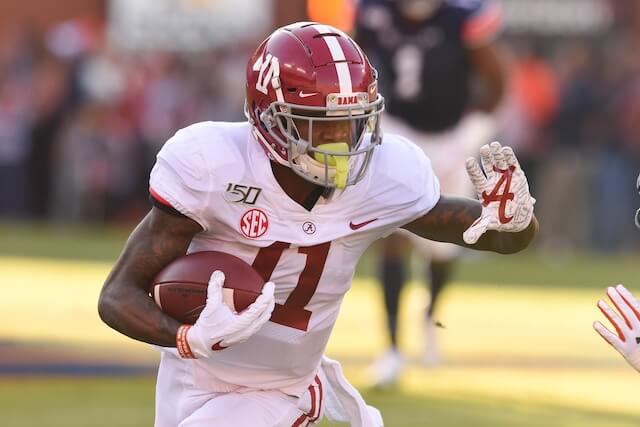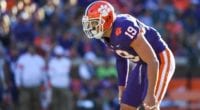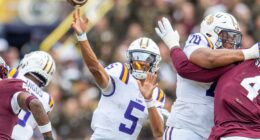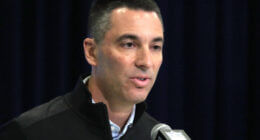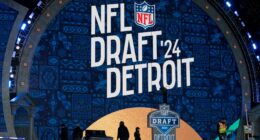This is the first in a series of new posts coming this week and next which will break down almost all of the Las Vegas Raiders’ new prospects (apologies to offensive lineman John Simpson). In addition to diving into tape, we also got the chance to talk with Thor Nystrom (Rotoworld’s lead NFL and NFL Draft Writer) who offered his insight into each of the players’ value.
When the Raiders were on the board at No. 12, they could have gone just about anywhere. Defensive lineman Javon Kinlaw was still on the board, as were all three of the top receivers — not to mention the Raiders reportedly had a trade offer on the table to move back to No. 14 (Peter King reports they were offered a fifth and sixth, in addition to a swap of third-rounders that would have moved them up five spots). But the Raiders decided to stay put and pick the guy they wanted most:
Alabama speedster Henry Ruggs III.
To be fair, most people were surprised — if not shocked. For those who weren’t following the draft process closely, Ruggs wasn’t the name they expected to be called first among fellow wideouts Jerry Jeudy and CeeDee Lamb. Why? Well, Ruggs only had 98 career catches — far less than Jeudy (159) and Lamb (173), not to mention the fear many people have about pure speed wide receivers (hey there John Ross and Darrius Heyward-Bey!).
“Here were the Raiders just being the Raiders…” or “Al Davis strikes again!” were all that you heard or saw on Twitter.
Except….this was different. Not only was Ruggs every bit the equal of Jeudy and Lamb — sometimes even higher on some peoples’ boards (he was ranked ahead of Lamb on mine) — but this wasn’t a guy who was just a speedster. When I interviewed Jim Nagy, a former NFL Scout who runs the Senior Bowl, he said this:
“Ruggs is my favorite and I think he’s the best one. He’s got a rare trait those other two guys don’t have. And he isn’t just a speed guy — he can run routes, he’s tough, he’s competitive, he goes inside, I mean, he catches everything. To me, Ruggs would be the pick. At No. 12 I wouldn’t take either of the other two (because of the depth at the position), but Ruggs would be hard for me to pass on. I really think he has a chance to be a difference maker.”
Well, the Raiders didn’t pass on Ruggs, and so it’s time to dive in a bit deeper into why this pick makes so much sense for Mike Mayock and Jon Gruden.
For starters, if you’re worried he’s just a straight-line speed guy, watch this:
I think it was John Middlekauf who said he looked like Desean Jackson mixed with Russell Westbrook, and, well, yeah. Nasty. (Not only did Ruggs have the fastest 40 at the combine, but he also had the second-highest vertical as well at 42″).
But what about on the football field? Well, if you watch one highlight, make it this one:
That’s an SEC defense, and when Ruggs catches the ball he is surrounded by FIVE Gamecock defenders. At the 40 yard line, he’s still got five dudes within a few yards of him — but 25 yards later they aren’t even in the shot anymore. He’s out here making SEC defenders look like they’re in slow motion (and note that this wasn’t just a straight-line deep ball, either).
Which brings us to the Raiders and where Ruggs fits in. When I wrote about Ruggs before the draft, the thing I liked most about him is the impact he would have on everyone else around him. In fact, I even warned that it’s possible Ruggs’ impact would be hard to quantify over the first few seasons — i.e. he may not produce statistics at an elite rate, and yet, his impact will be first-round worthy.
Here’s how Thor Nystrom of Rotoworld put it to me in an interview: “(Ruggs) changes the way the defense defends you on every play by tipping the field play in and play out. He’s going to force the safety to play back and slide over on every single play no matter what. His comp is Tyreek Hill, who is another guy you have to account for at all times — even when he isn’t getting the ball — which opens things up for other players.”
Now add this type of thinking into the way Jon Gruden wants to play football — with multiple tight ends and a fullback as much as possible. Every single time Ruggs is on the field, one safety is going to have to stay deep just to account for a possible play-action pass (for fear of getting beat over the top). That means one less defender in the box to defend against Josh Jacobs.
Now flip the script: what if the Raiders do run play action? Well, the linebackers will know they need to help against the run because they’re already down a man — which will open up the Ruggs slant right behind them, giving a guy with 4.27 speed the ball in space.
From The Athletic’s Ted Nguyen: “According to SSA, last season the Raiders faced eight defenders in the box on 226 plays. Only five teams faced eight defenders in the box more often (the 49ers, Titans, Vikings, Ravens and Broncos). The Raiders are hoping that Ruggs’ ability to threaten opponents deep will cause defenses to lighten up the box, play more two-deep coverages and open up things underneath for his new teammates.”
But I think Ruggs’ presence will also impact the rest of the receivers. Tyrell Williams ran a 4.43 himself coming out of college, meaning he’s another guy teams will have to account for going deep. Darren Waller? 4.46. Plus Josh Jacobs, Hunter Renfrow, Bryan Edwards and Lynn Bowden? Watch out.
It’s also worth noting that Ruggs is reliable as a receiver — he dropped just one pass last season and only four in his career as a whole. Part of the reason for that is the size of his hands: 10 1/8″, which was tied for the biggest among all receivers at the combine.
All in all, the Raiders got a difference-maker at No. 12 — and one that perfectly fits into what the Raiders need and want.
